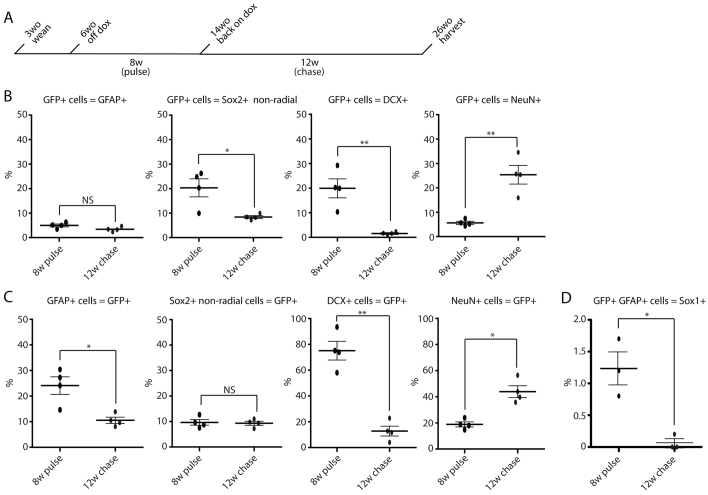Fig. 5.
Sox1-marked cells within the stem cell compartment are long lived and continue to give rise to new neurons. (A) Schematic of the timeline for back-on-doxycycline experiments. Sox1-tTA; LC-1; R26eYFP mice were taken off doxycycline at 6 weeks of age for 8 weeks (pulse; system on). They were then put back on doxycycline at 14 weeks of age for 12 weeks (chase; system silenced) and sacrificed at 26 weeks of age. (B) Quantification of GFP-positive lineage-traced cells that are radial GFAP positive, Sox2 non-radial positive, DCX positive or NeuN positive in mice kept off doxycycline (pulse) for 8 weeks (n=4, each black circle represents an individual mouse) or put back on doxycycline (chase) for 12 weeks (n=4, each red circle represents an individual mouse). Black bar represents the average. (C) Quantification of the percentage of all GFAP-positive radial astrocytes, Sox2-positive non-radial cells, Dcx-positive neuroblasts or NeuN-positive neurons that are also GFP positive in mice kept off doxycycline (pulse) for 8 weeks (n=4, each black circle represents an individual mouse) or put back on doxycycline (chase) for 12 weeks (n=4, each red circle represents an individual mouse). Black bar represents the average. (D) Quantification of the percentage of GFAP positive, GFP-positive radial astrocytes that are also Sox1 positive in mice kept off doxycycline (pulse) for 8 weeks (n=3, each black circle represents an individual mouse) or put back on doxycycline (chase) for 12 weeks (n=3, each red circle represents an individual mouse). Black bars represent the average; error bars indicate s.d. An average of 200 cells were counted per mouse. NS, no statistical significance; *P<0.05, **P<0.01.

